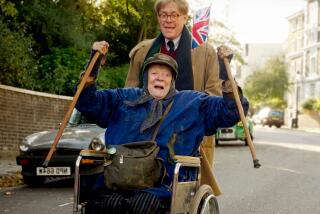Why do royal dramas reign? Queens in particular make for fascinating, complex stories
- Share via
It’s good to be queen. Or to be more precise, it’s good to play a queen in the type of sumptuous royal drama that often reigns supreme during awards season.
Consider: Helen Mirren won an Oscar as “The Queen.” Judi Dench portrayed Queen Victoria twice, in her Oscar-nominated “Mrs. Brown” and last year in the Golden Globe-nominated “Victoria & Abdul.” Cate Blanchett got nominated for “Elizabeth: The Golden Age.” Kirsten Dunst wore Oscar-winning costumes in Sofia Coppola’s “Marie Antoinette.” Danish Queen Caroline biopic “A Royal Affair” picked up a foreign language film Oscar nomination. And flashing back to the ‘60s, “Anne of the Thousand Days” delivered Geneviève Bujold a lead actress stauette for playing King Henry II’s wife one year after “Lion in Winter” star Katharine Hepburn won an Oscar for portraying Queen Eleanor of Aquitaine.
For the record:
11:55 a.m. Nov. 16, 2018This article says Geneviève Bujold’s character in “Anne of the Thousand Days” was married to King Henry II. She was married to King Henry VIII.
Hollywood’s fascination with female monarchs continues this fall. “Mary Queen of Scots” features Saoirse Ronan in the title role opposite Margot Robbie’s Elizabeth I, while “The Favourite” casts Olivia Colman as royal eccentric Queen Anne. Why do women in thrones continue to ring a bell for 21st century moviegoers?
“Queens not only manage all the complexities of wielding power, but they also do it against the backdrop of a society that’s uncomfortable with the very notion of a woman ruling,” observes “Mary Queen of Scots” writer Beau Willimon.
Margot Robbie, Christian Bale and nine more stars undergoing movie makeovers this awards season »
“When you take someone who’s both on the fringe and in the inner circle at the same time, it adds a layer to the dramatic complexity of the story. When you put these conflicts against a grand canvas with extraordinarily high stakes, it makes queens more interesting and attractive than their male counterparts.”
Willimon, who created the “House of Cards” series about backstabbing Washington, D.C., power brokers, pictures the 16th century history between Catholic Mary and Protestant Elizabeth as a potentially potent friendship gone horribly awry.
“Elizabeth and Mary both understood what it was like to be surrounded by men doing everything they could to manipulate, steer or diminish their reign, so there’s a certain camaraderie on that level,” he says. “But they also pose a threat to one another. How do you navigate the desire to coexist with this contradictory desire to dominate the other? That question is at the heart of this version of ‘Mary Queen of Scots.’”
Mary Stuart, daughter of King of Scotland James V, exuded imperial confidence from childhood.
“Her mother, Mary de Guise, was a supreme operator and Mary was groomed to become queen,” says Willimon, who based his script on John Guy’s “Mary, Queen of Scotts” biography.
“Oftentimes through the ages Mary has been portrayed as an impetuous, overly emotional young woman who made blunder after blunder, but Guy proposes that she was actually quite savvy, sure-footed and decisive, although I doubt that she ever felt too secure in her power. This was a time when people didn’t get impeached; they got murdered. They weren’t voted out of office; they were jetted off to the Tower.”
Rival Elizabeth began her reign crippled with uncertainty.
“She was born a bastard child and probably grew up worried about getting shipped off to a nunnery or being executed,” says Willimon. “When Elizabeth became Queen of England, there was great strife between Protestants and Catholics, not all that different between what you see today between conservatives and liberals. At the start of our story, Elizabeth has not yet become the stalwart, strong and fierce person we’ve seen dramatized before. She was much more insecure.”
WATCH: Video Q&A’s from this season’s hottest contenders »
Unlike the steely Queen of Scots and increasingly shrewd Elizabeth I, Colman’s Queen Anne in the 18th century-set tragicomedy “The Favourite” comes across as a needy, gout-afflicted monarch surrounded by 17 bunnies representing the children she lost through miscarriages or stillborn births. “That level of loss was very important to understanding Queen Anne’s character,” says “The Favourite” co-writer Tony McNamara. “We wanted to honor that part of her history and the rabbits showed this in a way that was tonally consistent with this woman who was a bit of a child.”
Teamed with director Yorgos Lanthimos, McNamara, who previously dramatized royal temperament in his 2008 Catherine the Great play “The Great,” kept England’s disastrous War of the Spanish Succession off-screen in order to focus on Queen Anne’s relationships with close advisor Sarah Churchill (Rachel Weisz) and Sarah’s seductive cousin Abigail (Emma Stone).
“Yorgos and I were drawn to the idea of these personalities being much bigger than the political story,” McNamara says. “We’re accustomed to thinking of politics as a much more rational pursuit, but in this film we wanted to show how the personal relationships between these three women changed the course of history. Queen Anne and Sarah and Abigail have everyday problems just like regular people. Apart from the fact that they’ve got pretty dresses and carriages, there’s a downside as well.”
More to Read
From the Oscars to the Emmys.
Get the Envelope newsletter for exclusive awards season coverage, behind-the-scenes stories from the Envelope podcast and columnist Glenn Whipp’s must-read analysis.
You may occasionally receive promotional content from the Los Angeles Times.










